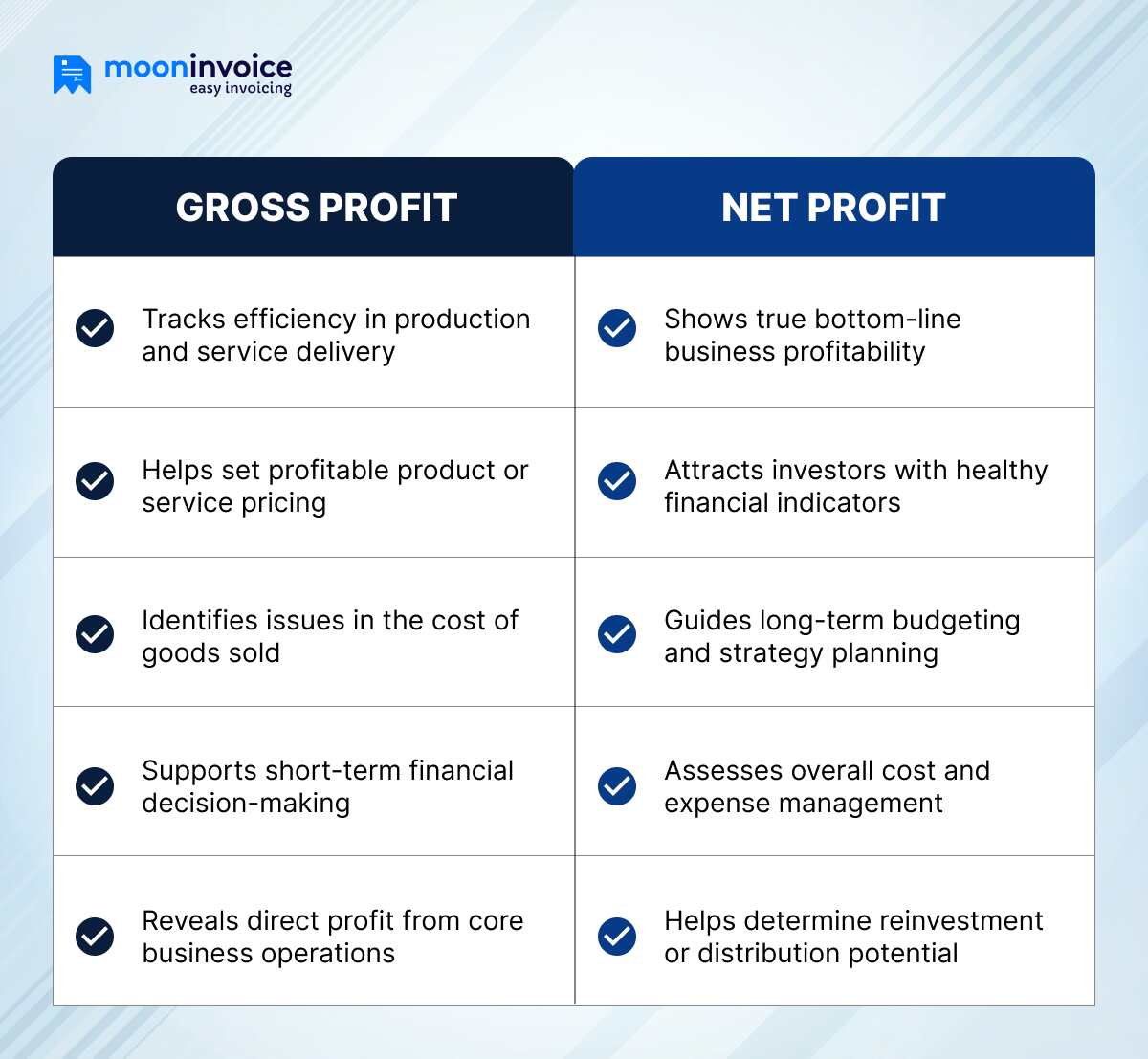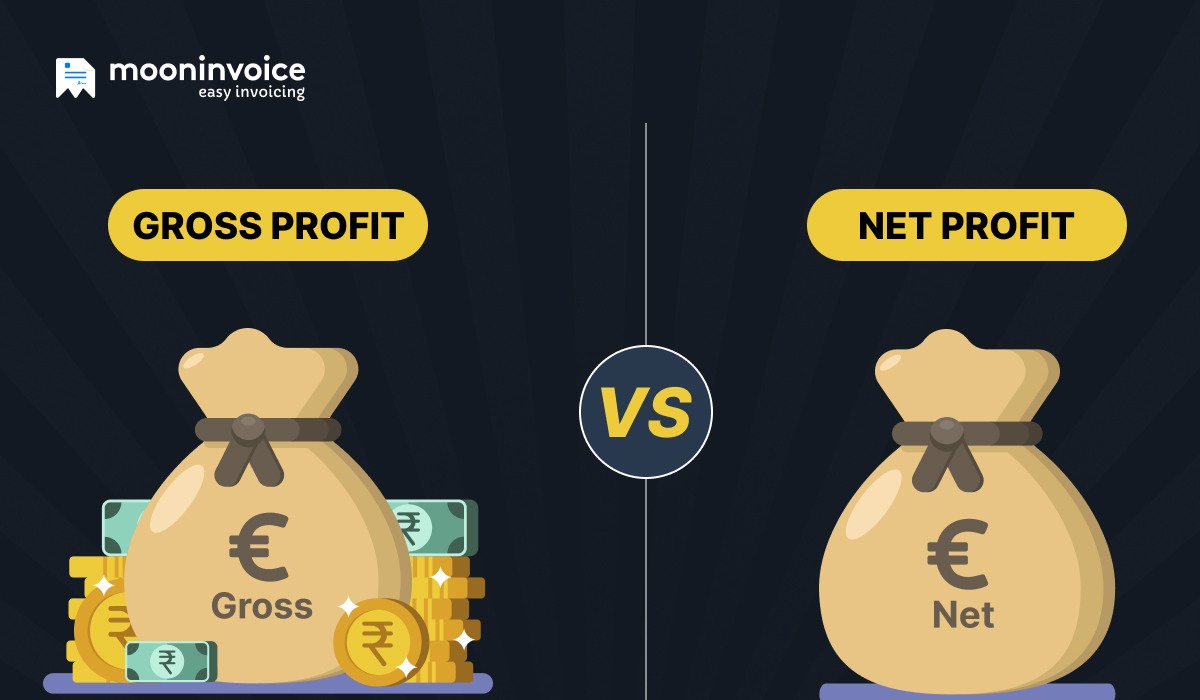To see your business grow every year is what every business owner imagines when they start a business. But imagination isn’t enough to manage a healthy cash flow.
You need to keep an eye on crucial business metrics. Revenue, expenses, and profit margin are among those key metrics that can aid you in determining whether your company is performing well.
In recent years, we saw many entrepreneurs and new businesses failing to calculate net profit and gross profit accurately, which eventually resulted in unwanted losses. According to recent article from Fibre Federal, more than 20% of businesses fail to achieve significant growth in their first year.
However, there is nothing to worry about as long as you know what is the difference between gross profit and net profit and other key metrics.
Let’s dive straight into gross profit vs net profit.
📌 Key Takeaways
- Gross profit measures earnings after direct costs, while net profit shows actual income after all business expenses.
- Gross profit comes after revenue and COGS, whereas net profit is listed at the bottom as the final income.
- Gross profit reveals how efficiently you’re delivering your product or service and whether your pricing is sustainable.
- Net profit reflects total financial health. It includes all costs and is essential for long-term planning, investment decisions, and overall business sustainability.
- Consider using software tools to simplify profit tracking, as they offer features such as invoicing, expense logging, and reporting.
What is Gross Profit?
The definition of gross profit is the amount a business earns from sales after subtracting the costs of goods sold (COGS). These are the costs directly associated with the production of goods or services you sell.
Gross profit is the initial part of understanding your business’s profitability. In simple terms, it can be said that gross profit is the money left after calculating the costs of producing or delivering your product or service. To calculate gross profit, you will require COGS data.
Expenses such as rent, utilities, administrative staff salaries, marketing, and taxes are not included in COGS.
Here’s the Gross Profit formula:
Gross Profit = Revenue (Sales) – Cost of Goods Sold (COGS)
Example of Gross Profit
Let’s say you run a concierge business. In one month, you earn $3,000 in revenue. The total cost of delivering services, including delivery expenses and other related costs, amounts to $1,820.
Gross Profit = $3,000 – $1,820 = $1,180
That $1,180 is your gross profit, which excludes rent, utilities, employee salaries, and marketing expenses.
Why is Gross Profit Important?
With gross profit, you will be able to know whether the core business operations are worth it or not. It answers questions like:
-
- Are you pricing your products/services correctly?
- Are your production costs beyond the acceptable range?
- Are you generating enough margin to sustain the business?
These questions give you answers to how you can further break down the production costs of your business.
What is Net Profit?
The definition of net profit (also known as net income) is the total profit a business earns after deducting all costs from its total revenue. It shows the true financial gain.
If gross profit is your first step in calculating profit, consider net profit as the final step. Net profit is the earnings after paying all expenses, not just the costs of goods or services. Simply, it can be said that net profit is the amount left in your pocket after paying rent, salaries, utilities, taxes, interest on loans, and more.
Here’s the Net Profit formula:
Net Profit = Gross Profit – Total Expenses (Rent, Utilities, Marketing, Taxes, Interests)
Example of Net Profit
Let’s go back to the example of a concierge business.
-
- Total Revenue: $3,000
- Company’s Gross Profit: $1,180
- Rent: $300
- Utilities: $100
- Marketing: $180
- Taxes and Interest: $100
Now, let’s calculate net profit.
Net Profit = $1,180 – ($300 + $100 + $180 + $100) = $500
So, even though your gross profit was $1,180, the actual money you made after the net profit calculation is $500.
Why is Net Profit Important?
Net profit is the exact money your business makes. It reflects the financial condition of your business, i.e., whether you are experiencing losses, an average profit, or a higher profit margin.
Here’s why it matters:
-
- Helps manage the operational expenses
- Helps create a financial roadmap for the long term
- Gives you a choice to decide what innovation or change you can do based on profit or loss
Tired Of Juggling Spreadsheets To Calculate Profits?
Make smarter profit decisions automatically! Switch to Moon Invoice and get real-time insights into your gross and net profit, all in one place!
Net Profit vs Gross Profit: The Difference
As a business owner, you must know that both gross profit and net profit are key financial metrics of your business. Gross profit determines how efficiently you produce and sell. On the other hand, net profit determines whether you are truly making a profit after covering all business expenses.
Let’s find out the core differences between gross and net profit.
1. Purpose and Usage
| Aspect | Gross Profit | Net Profit |
|---|---|---|
| Measures | Core profitability | Overall profitability |
| Helps analyze | Production efficiency, pricing strategy | Entire business health |
| Useful for | Managers, pricing teams | Business owners, investors, stakeholders |
| Decision-making impact | Short-term cost control | Long-term planning and sustainability |
2. What’s Included in Each?
| Feature | Gross Profit | Net Profit |
|---|---|---|
| Revenue | Included | Included |
| COGS | Subtracted | Subtracted |
| Operating expenses | Not included | Subtracted |
| Salaries (Admin/Office) | Not included | Subtracted |
| Rent, utilities | Not included | Subtracted |
| Interest, Taxes | Not included | Subtracted |
3. Reporting & Evaluation
-
- Gross Profit is often used to monitor day-to-day operations, especially in product-based businesses.
- Net Profit is used to evaluate financial success and performance across periods, such as quarterly or annually.
Now, let’s find out what role gross and net profit play in the P&L statement.
💡Pro Tip:
Always monitor your profit margins, not just the raw profit numbers. A high gross profit with a shrinking net profit often signals rising overhead costs.
Gross and Net Profit on the P&L Statement
The Profit and Loss (P&L) statement is considered the most important financial report in any business. It provides a clear understanding of how revenue is distributed in the business, what expenses are deducted, and the amount of profit ultimately left.
Both gross profit and net profit are listed on this statement, but at different stages.
Where Does Gross Profit Appear?
Gross profit is listed right below the company’s total revenue and COGS. It is the first profit that is considered, excluding operating costs.
Gross profit calculation is not a complex method; here’s how to find out.
-
- Gross Profit = Revenue – COGS
Where Does Net Profit Appear?
Net profit is listed at the bottom of the P&L statement, which is why it is also called the “bottom line.” It is the last and final profit of the business after deducting every operational & direct cost, employee wages, taxable income, and interest.
To calculate the net profit margin, you need to implement the formula, i.e.,
-
- Net profit = Gross Profit – Total Expense of the Business (Rent, Utilities, Marketing, Taxes, Interests)
Unaware of Where Your Money is Going?
Stop guessing and start tracking. With Moon Invoice, gain clarity on your revenue, expenses, and true profits.
Benefits of Gross Profit & Net Profit

How Do Gross Profit and Net Profit Affect Expenses?
Isn’t it important to know how your profits impact your business expenses? Yes, it is very important. Gross profit and net profit play a large role in how you manage costs and plan budgets for the next financial year.
Let’s explore how the company’s net profit margin and gross profit margin affect business expenses.
1. Gross Profit’s Role in Managing Direct Costs
The gross profit of your business is directly proportional to the cost of goods sold (COGS) of your business.
If your gross profit is going down, it could be:
-
- High production costs
- Underpriced products/services
- Increased supplier rates or material costs
The above disrupts the financial outcome because when you spend more on production, you will have less left over. This is why analyzing gross profit vs net profit helps spot financial inefficiencies early.
2. Net Profit’s Role in Managing Total Business Expenses
Net profit is the amount of money that goes into your pocket after paying all expenses related to your business, i.e., rent, salaries, software, marketing, interest, and taxes.
If your net profit is decreasing even after achieving a healthy gross profit, it means your operating margins are too high. The major reasons could be:
-
- No budgets and plans while spending on marketing
- Improper workflow, unnecessary subscription plans
- Tax burdens and high-interest payments
- The office is located in an overpriced area
Net profit vs gross profit analysis is necessary because you get to know exactly where you need to improve.
Moon Invoice: Your Go-to Solution to Every Profit Calculation
Moon Invoice simplifies your expense tracking process in a way that you can monitor both incoming and outgoing cash flow. It comes with built-in tools to manage business finances as well as payments. With Moon Invoice, businesses can calculate their gross margin, net profit, total revenue, and other metrics accurately in less time.
Here’s why you should introduce Moon Invoice in your business:
-
- Easy-to-use invoicing & estimating: 60+ customizable invoice and estimate templates to cut down on time taken for invoicing and estimation.
- Purchase orders & credit notes: Manage purchase orders and issue credit notes whenever required.
- Expense tracking & time logging: Directly log expenses and billable hours in the app, then convert them into invoices.
- Reporting & financial insights: Comes with 15+ business reports to help you make important financial decisions.
- Recurring invoicing & auto-billing: Set up automated recurring billing for regular invoices and ease the daily hassles.
In Short
The difference between gross profit and net profit is one of the most important aspects of a business’s financial health. As a business owner, it is necessary to find gross profit, net profit, operating profit, and other metrics that offer unique insights into your business’s performance.
For that, what you can do is bring in sophisticated software that adapts to your needs and empowers you to decide on what’s ideal for your business.
So, why wait? Let’s first start with your profit margin. Utilize our free profit margin calculator now and check out how it can be done within a matter of minutes.



















